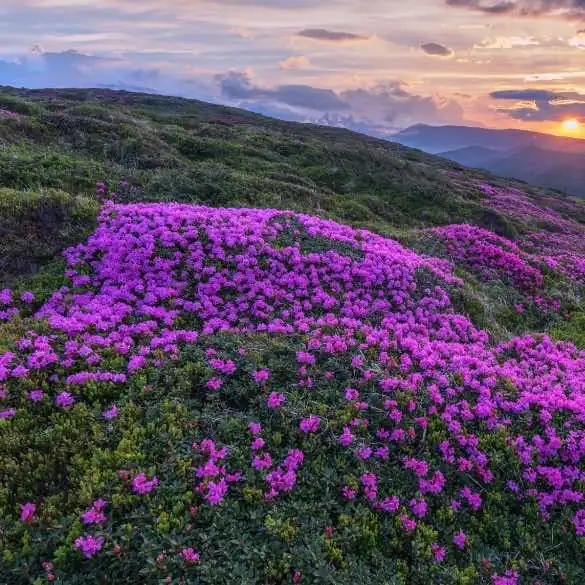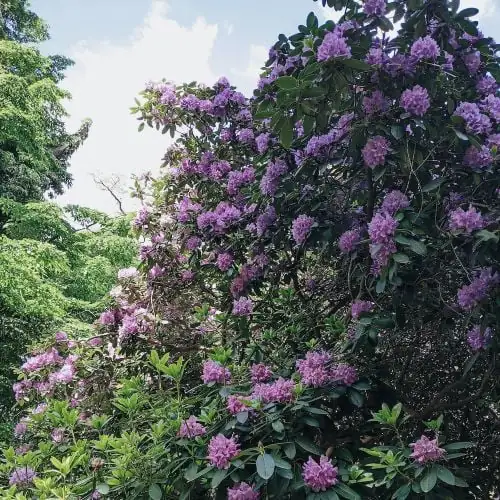Rhododendron ponticum identification
Read through our Rhododendron identification guide below. If you are still not sure, email us your photos and we’ll confirm whether it’s Rhododendron for FREE
Quick facts
- Rhododendron outcompetes native flora.
- Rhododendron can cause ‘Mad Honey Disease’.
- Flowers in June and July.
- Shrubbery can create monocultures.
- Can produce over 1 million seeds a year.



Quick Links

What does Rhododendron ponticum look like?
Rhododendron is a very large genus of woody plants that averagely reaches 3.5m tall and can be seen up to 10m tall in the wild. There are about 1,024 different species of Rhododendron which are usually native to North America, Asia or the Himalayas. Commonly known as Rhododendron or Azalea, these woody shrubs exhibit spectacular flower displays in the summer months in groups of 14 to 25 bell-shaped flowers that grow in clusters of pink or purple.
A common sight in many parts of the UK and in many ornamental gardens, Rhododendron ponticum has dark green, thick, glossy leaves that are evergreen. Woody stems become more like the trunk of a tree as Rhododendron ages.
Rhododendron can flower earlier or later dependent on its environment, for example it has been noted that in warmer climates flowering has been seen between December and March and in colder climates, between April and May.
Is Rhododendron ponticum an invasive plant?
Yes, Rhododendron ponticum is considered an invasive species in many regions. Native to southwestern Europe and Northwest Asia, it has become problematic in areas where it has been introduced. The invasive characteristics of Rhododendron ponticum include rapid growth, dense foliage, and the ability to outcompete native vegetation.
Invasive species like Rhododendron ponticum can have negative impacts on ecosystems by displacing native plants, altering habitat structures, and reducing biodiversity. The dense thickets formed by this species can prevent the growth of native vegetation and limit the resources available to other plants.
Efforts are often made to control or manage the spread of invasive species, including Rhododendron ponticum. This may involve manual removal, the use of herbicides, or other methods to prevent further colonisation and degredation of native ecosystems.
It’s important to act against the spread of invasive species to protect the biodiversity and ecological balance of natural environments. Local environmental agencies and conservation organisations often provide guidance on the management of invasive species in specific regions.
In the UK, it is legal to own Rhododendron ponticum, however, it is listed under Schedule 9 of the Wildlife and Countryside Act 1981, meaning it is illegal to plant it into the wild or allow it to spread from your property. Any waste material must be disposed of responsibly to a licenced waste facility.
What does rhododendron look like in Autumn?
Rhododendron ponticum, being evergreen, maintains its green foliage throughout the year, meaning you won’t observe the leaves transitioning to yellow, red, or purple. However, there is a possibility of the leaves taking on a rusty colour if they experience winter sunburn.
How do you identify Rhododendron in the Winter?
Rhododendrons are evergreen and are winter hardy. In the winter, water evaporation occurs, and the dark green leaves can droop and curl in slightly to protect themselves from the cold weather.
Rhododendron roots enter dormancy in the winter but can continue to grow if the soils thaw and become active again. This is called winter quiescence which is a tactic used by woody evergreen plants to absorb water from the soils to ensure they keep their leaves.



How does Rhododendron grow?
Rhododendron can spread both by seed dispersal and something called Stem Layering.
Seeding
- Seed spread occurs following flowering. Rhododendrons usually flower after around 12-20 years of growth, although this time can be reduced if the plant is recovering from cutting, flowers can be seen after about 2 years of regrowth. Mature plants can produce around 1 million seeds which can invade or re-invade an area with suitable ground conditions quite easily.
- The most susceptible areas are disturbed ground and areas recently cleared of other mature vegetation.
- Seeds only remain viable for around 1 year; however, germination can occur in many variations of soil conditions.
- Seeds are very light and small, and dispersal is mostly windborne, reaching up to 500m from the parent plant.
- Seedlings grow very slowly in the first few years, which can be a hindrance in control methods; monitoring visits need to occur for multiple years to ensure no further regrowth occurs.
Stem Layering
- Slow vegetative spread that relies on fallen branches re-rooting in the ground.
- Collapsed branches fall to the ground and can re-root in the ground. This is a slow process and is more often seen at the edge of stands of Rhododendron and where mature trees have fallen.
- This spread causes densely interwoven stems in areas that otherwise may not be suitable for seed germination such as wet ground where seedlings would likely die.
Interesting facts about Rhododendron ponticum
Introduced to the UK from Gibraltar in 1763 as an ornamental garden plant, by the mid-1800’s Rhododendron ponticum was being sold in London markets as a popular garden plant.
Rhododendron spreads via a powerful seed dispersal system and large infestations have been noted in the wild in upland areas around the country, particularly in the Snowdonia National Park in North Wales where a large-scale multimillion pound project has been undertaken to control the spread of the plant. Rhododendron was found to be growing at a rate of 1km every five years in the Hebrides in Scotland and cost approximately £120,000 per year to manage and eradicate!
Rhododendron roots are toxic! They produce grayanotoxins which are found in the leaves, roots and stems of the plant. This is used as a defence technique for the plant, ensuring grazing herbivores find the plant unpalatable. This is where ‘Mad Honey Disease’ comes from! This poison is toxic to humans, pets, horses, birds and livestock.
When bees pollinate the flowers of the plant and return the nectar to their hives, the honey that is produced contains the poisonous grayanotoxins and can cause significant stomach-upset and cardiac discomfort (Arrhythmia).

Is Rhododendron a problem?
Yes!
As with other invasive species, Rhododendron ponticum is especially hardy and able to grow in many weather and soil conditions. This allows the plant to grow to large capacities around the country, it shades out other native vegetation and can cause reduced biodiversity. Specifically with Rhododendron ponticum, there is evidence of long-term debilitating effects to the soils in which it is found. The toxins found in the plant seep into the soils surrounding it which increases the acidity, causing reduced growth of other native species. Also, the resulting leaf litter becomes slow-decaying which in turn causes the soils to become infertile and low in nutrients. Over time, this can cause the natural balance of an eco-system to shift and become less encompassing for other biodiverse species.
What can you do?
Best Rhododendron ponticum removal methods
Rhododendron ponticum can be effectively tackled by a professional invasive species company and we use various tactics dependant on the size of the infestation and requirements of removal.
- Hand pulling.
- Mulching.
- Herbicide application.
- Stump treatment.
- Excavation.
Dependant on the size of infestation, multiple techniques can be undertaken to control or eradicate Rhododendron ponticum from your property. Find out more by visiting our Rhododndron ponticum removal page.
Which alternatives to Rhododendron ponticum can I plant in my garden?
If you’re looking for alternatives to Rhododendron ponticum for your garden, consider some of the following plant options, which all look as beautiful and won’t be as problematic:
- Other Rhododendron Species: Instead of the invasive Rhododendron ponticum, consider non-invasive rhododendron species such as Rhododendron hirsutum (hairy alpenrose) or Rhododendron ferrugineum (alpine rose).
- Azaleas: Many azalea varieties are suitable for the UK climate and provide a wide range of colours and sizes.
- Heathers (Calluna vulgaris and Erica spp.): These hardy, low-maintenance plants are well-adapted to acidic soils and offer year-round interest.
- Camellias: These evergreen shrubs thrive in the UK climate and produce beautiful flowers.
- Hydrangeas: Well-suited to the UK climate, hydrangeas come in different varieties and produce large, showy blooms.
- Fuchsia: These colourful, pendulous flowers are well-loved in UK gardens and attract hummingbirds.
- Lavender (Lavandula spp.): Fragrant and drought-tolerant, lavender is a great addition to a UK garden.
Start fixing your invasive plant problem today by requesting a survey
Request a survey
Rest assured, where invasive species are identified at an early stage and tackled correctly, problems can usually be avoided. Our specialist consultants complete thorough surveys to identify the extent of the problem. Our plans aren’t one-size-fits-all; they’re customised to tackle the invasive species at your property effectively, taking account of all of your requirements.
What our clients say
Reviews
What our clients say
Reviews
Bernadette Spencer
“Richard was able to book us an assessment visit very quickly regarding the encroachment of evasive running bamboo in our garden .. Will completed the assessment visit,we found him to be very professional, but also friendly and easy to talk to. “
Ali Hamaad
“I used Environet following a recommendation to help with invasive Japanese Knotweed in my garden. Very professional, responsive and managed to co-ordinate with other contractors working on my property to remove the knotweed.”
Phil Smith
“This is a very professional operation; always just on the end of the phone. The whole team seemed to know exactly what was going on with the job. (and my neighbours were very happy too.)”
Kim
“I’d just like to take the time to commend the team I have spoken to already, in particular Rachel and Suzie – they have been so friendly, reassuring and informative which has really eased the stress around this situation. Thank you all for your time. .”
L Schjolden
“I would like to commend your man Ed, who was in charge of the works at our property. He was a pleasure to deal with — punctual, polite, professional, responsible. He always kept me up to date with the progress of the works and made sure there was as little disruption to our lives as possible.”



